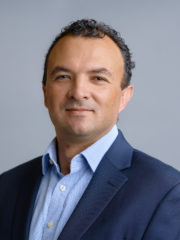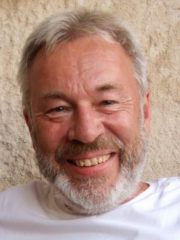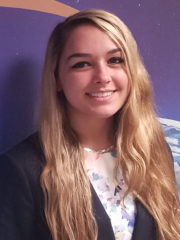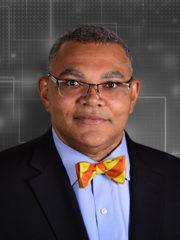April 6, 2022
Conference Keynote
“NASA’s Aeronautics Research Portfolio and Strategic Direction”
Robert Pearce, NASA Associate Administrator for the Aeronautics Research Mission Directorate
Robert A. Pearce is the associate administrator for NASA Aeronautics Research Mission Directorate (ARMD). Pearce manages the agency’s aeronautics research portfolio and guides its strategic direction, including research in quiet supersonic flight over land, urban air mobility, autonomy, highly efficient advanced air vehicle concepts, electrified aircraft propulsion, advanced materials, airspace operations and safety, integration and flight demonstrations of aviation systems, and the nurturing and development of transformative concepts for aviation.

Plenary III: International Aspects of Advanced Air Mobility
Description
The vision of Advanced Air Mobility (AAM) is to provide an ecosystem of safe, sustainable, affordable, and automated air transportation for passengers and cargo capable in urban and rural environments. Leaders from government and industry will provide insights and updates on AAM development and harmonized approaches to AAM.
Co-chairs
Steve Bradford, Chief Scientist for Architecture and NextGen Development, FAA
Steven W. Bradford is the Federal Aviation Administration’s (FAA) chief scientific and technical advisor for architecture and Next Generation Air Transportation System (NextGen) Development. He is the chairman of the Technical Review Board, which monitors technical decisions, related investments, and the enterprise architecture. Mr. Bradford works with elements of the FAA to develop midterm plans and five-year budget requests to implement NextGen. He is the FAA’s lead for the FAA/NASA Research Transition Team process that supports collaboration between the FAA and NAS on ATM -related activities. He also has a leading role in NextGen’s international engagement activities with SESAR Joint Undertaking, and he has led several co-operative international efforts with EUROCONTROL. He was a member of the International Civil Aviation Organization’s (ICAO) technical team that authored the Global Air Navigation Plan, the past U.S. panel member to the ICAO Air Traffic Management Requirements and Performance Panel, and the chairman of the Global Air Navigation Plan Study Group responsible for managing all updates to that plan.

Davis Hackenberg, Advanced Air Mobility Mission Integration Manager, NASA
Davis Hackenberg is currently serving the NASA Aeronautics Research Mission Directorate (ARMD) as the Advanced Air Mobility (AAM) Mission Integration Manager. He performs his duties from NASA Headquarters in Washington DC. Mission Integration Manager duties for AAM include strategic mission planning and leading the development and implementation of the AAM mission spanning all relevant ARMD project and center research activities with the goal of implementing the NASA AAM investment strategy in a manner that accelerates AAM. Davis is responsible for strategic and technical management, including integration with multiple government agencies ensuring that the products of this effort are relevant and will be utilized by all customers and stakeholders.

Panel Members
In order of appearance
Davis Hackenberg, Advanced Air Mobility Mission Integration Manager, NASA, “NASA AAM International Talk Overview”
See bio above
Gary Cutts, Future Flight Challenge Director, UK Research and Innovation, “A Novel Approach to Air Mobility”
Gary Cutts is the director of ISCF Future Flight Challenge and has 30 years’ experience in the Aviation industry, mainly working on complex engineering systems, but with experience in business development, customer consultancy and services creation. He has held many global engineering, executive leadership positions in Rolls-Royce working across the product lifecycle including creating the system design function and leading the digital transformation of Engineering for the group. He has also been a board member at the Centre for Modelling and Simulation. Gary is now leading the UK government’s Future Flight Innovation Program working across government and industry to create innovative new aviation systems. Gary’s passion is to bring teams together to challenge the status quo and drive step changes in both the technology and business thinking to transform the aviation industry.

Erick Corona, Director of Prod. Mgmt. & UAS Ops Engineering, Wisk Aero, “The Case for Advanced Air Mobility – Beginning with the Current NAS and Beyond”
Erick Corona is the director of Product Management and Unmanned Air System Operations at Wisk Aero LLC., a company focused on addressing congestion by deploying self-driving electric vertical-take-off and landing (eVTOL) aircraft. Working at the intersection of aeronautics, robotics, telecommunications, and battery technology, the company aims to deliver a safe, sustainable, affordable, and beyond-cool means of urban transportation. Before Wisk, as director of Products at C3.ai, Erick led the development of AI-capable Predictive Maintenance solutions now deployed within DoD. Prior assignments include management, flight test, and engineering design positions at Boeing and GE Aircraft Engines. Erick also led the adoption of data-driven infrastructure asset management efforts at Pacific Gas and Electric.

Tom Prevot, Joby Aviation, “Joby Aviation: Designed for Today’s System, Adaptable for Tomorrow”
Dr. Thomas (Tom) Prevot is the air taxi product lead at Joby Aviation. He and his team are developing the air taxi service for the future Joby network of electric Vertical Take-Off and Landing (eVTOL) aircraft. Tom joined Joby in January 2021, after having been the director of engineering for Airspace Systems at Uber Elevate since 2017. Prior to joining Uber, Tom was with NASA Ames Research Center for more than 20 years. Tom is passionate about developing and evaluating future concepts and technologies for the air transportation system. He has published over 100 conference and journal papers.

Plenary IV: Future I-CNS Emerging Technologies to Support ATM
Description
The demand for information to improve operations is increasing across aviation stakeholders. Anticipated fleet growth (delayed by COVID-19) of air transport aircraft and the growth of emerging airspace users are fueling this demand. Additionally, ANSPs around the globe envision new traffic management concepts to accommodate the demand for access to airspace. Information centricity is seen as a key element of this future environment. Come see what technologies are in the future to meet this demand and a framework toward capitalizing on new space-based communication technologies.
Co-chairs
Bob Lee, Owner & Principal Consultant, GXA Consulting
Bob Lee is owner and principal consultant at GXA Consulting LLC and has 40 years of experience in the development of electronic systems with most of that time focused on aviation solutions for commercial and business aircraft. He is currently engaged in helping clients in the areas of performance-based communications systems, and traffic management concepts for emerging airspace users. Previously, Bob spent over 30 years at Collins working in a wide range of roles including systems engineering, program management, and developing business and technology strategies for their commercial businesses. His background extends across multiple product areas including communication, navigation and surveillance systems, air-to-ground communications, and various flight deck systems. Bob is a regular contributor to industry activities at Aerospace Industries Association, EUROCONTROL, RTCA, ICCAIA and ICAO. He is the past chair of the CNS/ATM committee at ICCAIA.

Rainer Koll, Senior Advisor, Stellar Solutions
Rainer J. Koll has over 30 years technical and executive management experience in aerospace industries. During that time, advancement of the aviation communications state- of-the-art has been at the heart of his career. Working as engineering group leader and director at Inmarsat and ICO Global Communications, he was responsible for the Classic Aero Satcom and Next Generation Satellite System (NGSS) developments. As managing director and VP of Thales Avionics Ltd. (UK), Rainer J Koll chaired the Honeywell/Thales executive committee that managed the joint SATCOM business. He also launched the developments of Thales’s TopFlight SATCOM. From 2010 to 2016, R J Koll was chief executive of Stellar Solutions Aerospace Ltd. He is now senior advisor at Stellar Solutions Inc. and currently focuses on supporting the FAA on NGSS SATCOM Performance Class B standardization tasks at ICAO, RTCA and AEEC. Koll is a fellow of the Royal Aeronautical Society and an accomplished private pilot.

Panel Members
Bob Lee, “Introductions and Opening Remarks”
See bio above.
Michelle Cady, Program Manager/Aerospace Engineer, FAA “Connected Aircraft Concept – A performance-based approach”
Michelle Cady is the FAA project manager for the Connected Aircraft program. As part of the Advanced Concepts Branch in the FAA’s NextGen Technology Development and Prototyping Division, she is responsible for the planning, coordination, validation, and development activities associated with Connected Aircraft in the FAA. Ms. Cady leads the development of FAA Connected Aircraft Concept of Operations and is a technical advisor on the ICAO Air Traffic Management Requirements and Performance Panel (ATMRPP), contributing to the development of the Global Connected Aircraft Concept. She also leads the coordination of Connected Aircraft activities to ensure alignment of policies, standards, technology, and operations across the FAA. As part of her role to accelerate adoption of the Connected Aircraft, she works closely with FAA, NASA, and industry research, demonstration, and flight test teams to identify use cases to align the business case and technology. Ms. Cady has been with the FAA since 2016 and has been working towards bringing the latest technological innovations into the FAA, including the integration of operations above FL600 (Upper Class E Traffic Management [ETM]) and development of an “app store” prototype to house FAA applications.

Jerry Hancock, Director, Aviation Cybersecurity, INMARSAT, “Orchestrating Change for Future Aviation Communication Systems”
Jerry has worked in the aviation industry for the past two decades, focusing on cybersecurity solutions for ground and air-ground data connectivity and aviation systems. He is currently Director of Aviation Cybersecurity at Inmarsat, where he has spent the last 5 years ensuring the integration of security of Inmarsat aviation solutions for commercial and uncrewed aircraft. Prior to Inmarsat, Jerry worked at the Federal Aviation Administration for 15 years supporting various programs, including the FAA telecommunications Infrastructure (FTI), cybersecurity protections of FAA networks, and future cybersecurity architecture and planning of FAA NextGen programs. With a passion for helping guide future regulations and standards, Jerry actively participates in multiple industry groups and organizations to support the future development and integration of information security throughout the end-to-end aviation ecosystem for both commercial and uncrewed civil aviation.

Rainer Koll, Senior FAA Advisor, Stellar Solutions, “Emerging Space-Based Systems for ATM Communications”
See bio above.
Awards Ceremony
Presentation of ICNS Champion Awards & AIAA Sustain Service Award
Evening Keynote
“Towards Increasingly Autonomous Aircraft-enabled Mobility”
Dr. John-Paul Clarke, Professor and Ernest Cockrell, Jr. Memorial Chair in Engineering, University of Texas at Austin
John-Paul Clarke is a professor of Aerospace Engineering and Engineering Mechanics at The University of Texas at Austin, where he holds the Ernest Cockrell Jr. Memorial Chair in Engineering. Previously, he was a faculty member at the Georgia Institute of Technology and the Massachusetts Institute of Technology (MIT); Vice President of Strategic Technologies at United Technologies Corporation (now Raytheon); and a researcher at Boeing and NASA JPL. Prof. Clarke is an expert in the development and use of stochastic models and optimization algorithms to improve the efficiency and robustness of complex systems, with a particular focus on aviation. For example, his work has led to the development of the world’s first fully autopilot-coupled continuous descent arrival procedure to be used in daily operations; airline schedules that are “robust” to poor weather and/or aircraft failures; and a state-of-the art algorithm to maximize the likelihood of success for a portfolio of research and development projects (or financial assets) with uncertain future performance and schedule.


